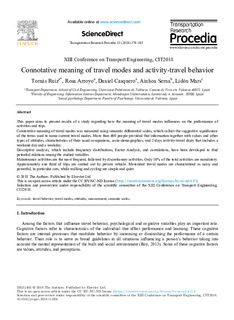| dc.rights.license | Attribution-NonCommercial-NoDerivatives 4.0 International | * |
| dc.contributor.author | Serna, Ainhoa | |
| dc.contributor.other | Ruiz Sánchez, Tomás | |
| dc.contributor.other | Arroyo López, María Rosa | |
| dc.contributor.other | Casquero Soler, Daniel | |
| dc.contributor.other | Mars Aicart, Lidón | |
| dc.date.accessioned | 2022-07-04T10:34:18Z | |
| dc.date.available | 2022-07-04T10:34:18Z | |
| dc.date.issued | 2018 | |
| dc.identifier.issn | 2352-1457 | en |
| dc.identifier.other | https://katalogoa.mondragon.edu/janium-bin/janium_login_opac.pl?find&ficha_no=162942 | en |
| dc.identifier.uri | https://hdl.handle.net/20.500.11984/5618 | |
| dc.description.abstract | This paper aims to present results of a study regarding how the meaning of travel modes influences on the performance of activities and trips.
Connotative meaning of travel modes was measured using semantic differential scales, which collect the suggestive significance of the terms used to name current travel modes. More than 400 people provided that information together with values and other types of attitudes, characteristics of their usual companions, socio-demographics, and 2-days activity-travel diary that includes a weekend day and a weekday.
Descriptive analysis, which include frequency distributions, Factor Analysis, and correlations, have been developed to find potential relations among the studied variables.
Maintenance activities are the most frequent, followed by discretionary activities. Only 10% of the total activities are mandatory. Approximately one third of trips are carried out by private vehicle. Motorized travel modes are characterized as noisy and powerful, in particular cars, while walking and cycling are simple and quiet. | en |
| dc.language.iso | eng | en |
| dc.publisher | Elsevier Ltd | en |
| dc.rights | © 2018 The Authors. Published by Elsevier Ltd. | en |
| dc.rights.uri | http://creativecommons.org/licenses/by-nc-nd/4.0/ | * |
| dc.subject | travel behavior | en |
| dc.subject | travel modes | en |
| dc.subject | attitudes | en |
| dc.subject | measurement | en |
| dc.subject | semantic scales | en |
| dc.title | Connotative meaning of travel modes and activity-travel behavior | en |
| dcterms.accessRights | http://purl.org/coar/access_right/c_abf2 | en |
| dcterms.source | Transportation Research Procedia | en |
| local.description.peerreviewed | true | en |
| local.description.publicationfirstpage | 379 | en |
| local.description.publicationlastpage | 385 | en |
| local.identifier.doi | https://doi.org/10.1016/j.trpro.2018.11.004 | en |
| local.contributor.otherinstitution | https://ror.org/01460j859 | ca |
| local.contributor.otherinstitution | https://ror.org/043nxc105 | ca |
| local.source.details | Vol. 33. Pp. 379-385 | en |
| oaire.format.mimetype | application/pdf | |
| oaire.file | $DSPACE\assetstore | |
| oaire.resourceType | http://purl.org/coar/resource_type/c_6501 | en |
| oaire.version | http://purl.org/coar/version/c_970fb48d4fbd8a85 | en |








